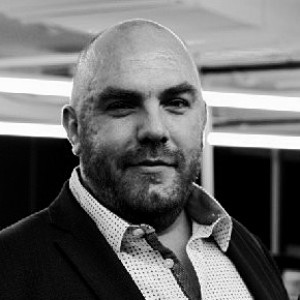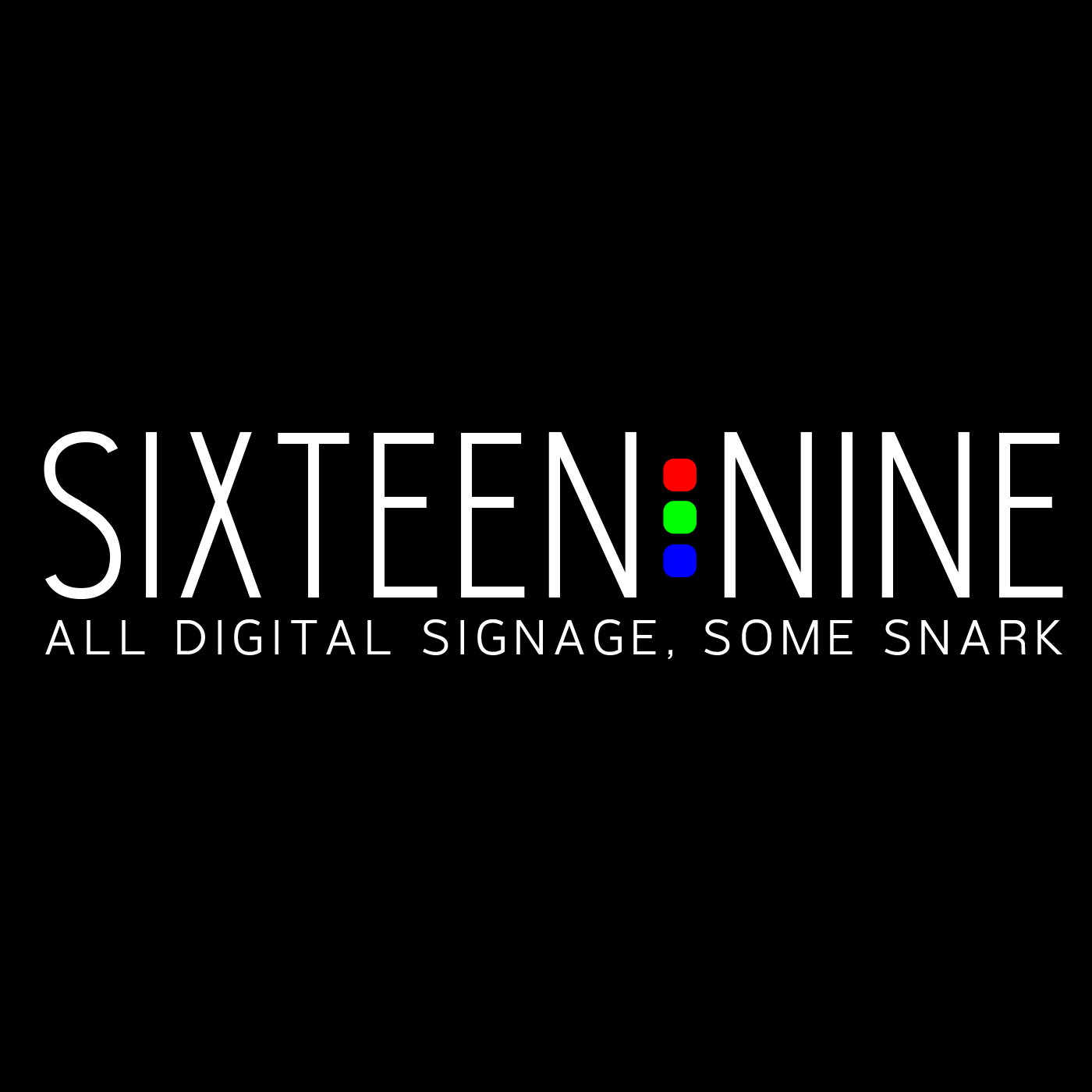Episodes

Wednesday May 13, 2020
Rick Mills, Creative Realities, Inc (CRI)
Wednesday May 13, 2020
Wednesday May 13, 2020
Creative Realities is a solutions provider heavily focused on retail, an industry that has been pretty much shuttered in the United States and everywhere other than Sweden because of COVID-19.
These are rough times for store operators for the people who run them, the people who work in them, and the industries that support retail, like digital signage.
While CRI's CEO Rick Mills agrees it's a dark period, he also has a lot of optimism - particularly for the retailers who have the fundamentals to be around when doors are allowed open again, and for service providers who have the tools and know-how to help address what will be new norms.
Mills and I chatted last week about what CRI is doing, as well as about new pandemic-focused tools like thermal sensing screens that his company has started marketing. We spoke, as well, about his company's outlook, including thoughts of acquiring one or several of the companies who are competitors right now, but might not come out of this situation in one piece.
Subscribe to this podcast: iTunes * Google Play * RSS

Wednesday Apr 29, 2020
Florian Rotberg, Stefan Schieger - Invidis Consulting
Wednesday Apr 29, 2020
Wednesday Apr 29, 2020
Florian Rotberg and Stefan Schieker of Munich's Invidis Consulting have been active in the digital signage market since 2006, mainly focused on Europe, the Middle East and Asia.
Their work spans everything from straight-up consulting for vendors and end-users to organizing and running industry conferences in Europe and globally.
That puts them in steady touch with a lot of people, and gives them a solid perspective on what's going on and what's changing.
One of the things Invidis has been doing in presentations is a regular look at the impacts and implications on vertical markets of COVID-19, and what that means for digital signage companies.
We talk about that in this new podcast, as well as dig into some suddenly red-hot marketplace requirements like sidewalk displays and access control technologies.
Subscribe to this podcast: iTunes * Google Play * RSS

Tuesday Apr 21, 2020
Kim Sarubbi, Advocates For Connected Experiences (ACE)
Tuesday Apr 21, 2020
Tuesday Apr 21, 2020
There are a lot of special interest member organizations out there, all focused on the things they do as businesses, but also on the trends and market forces that affect them.
There is a hell of a lot of crossover when it comes to things like customer experience, but historically, there's been very little crossover between these special interest organizations.
In simple terms, an issue that's important to a digital signage network operator can be important, as well, to an advertising company and to a location-based marketer. Privacy issues is a prime example of that.
A new organization called Advocates for Connected Experiences - or ACE - has bubbled up in recent weeks with the goal of getting different organizations collaborating on these kinds of common interests. It's not a member organization you'd join, but more of a working group.
I spoke with Kim Sarubbi, who stuck up her hand and said she'd pull ACE together. She gives the back-story, and tells me what ACE is doing, and where she could use help in what is, right now, totally a volunteer effort.
Subscribe to this podcast: iTunes * Google Play * RSS

Wednesday Apr 15, 2020
Remi Del Mar, Epson
Wednesday Apr 15, 2020
Wednesday Apr 15, 2020
For a bunch of years, projection seemed like one of these digital signage technologies that had seen its day.
But that's changed in the last two or three years, and if you follow the industry and go to trade shows, you're seeing more projection product and applications.
The big reason is lasers, which last way, way longer than the lamps that were used for many years in projectors.
The big projection guys like Christie, Barco and NEC have a range of suitcase-sized products that get used for big budget events, but another company more historically known for office products has made a strong and interesting expansion into digital signage and visual experiences.
Epson has a variety of projectors that can be applied to signage jobs, but the one that has got most of the attention lately is the LightScene. It looks entirely different from boxy projectors - instead looking very much like the spotlights you see hanging from track systems in shops and galleries. It changes the whole idea of projection in key markets like retail and museums.
I spoke with Remi Del Mar, the LA-based product manager who runs Epson's LightScene team.
Subscribe to this podcast: iTunes * Google Play * RSS

Wednesday Apr 08, 2020
Sean Wargo, AVIXA
Wednesday Apr 08, 2020
Wednesday Apr 08, 2020
AVIXA, the trade association for the pro AV industry, has started doing a weekly impact survey with members in North America and internationally - as a way of understanding how hard the pandemic is hitting business, and the collective point of view on what is happening, and will happen.
As you might imagine, things don't look so hot. Sales are down, and revenues with them. Jobs are being furloughed or ended. And even businesses that would, in theory, be rocking - like video conferencing - are struggling with supply chain issues.
But it's not all doom and gloom, and even in rough times, good things can happen.
Sean Wargo, AVIXA's Senior Director of Market Intelligence, runs the impact surveys. He was kind enough to take some time the other day to walk through what he is hearing, and also what AVIXA is doing with and for its members.
Subscribe to this podcast: iTunes * Google Play * RSS

Wednesday Apr 01, 2020
Chris Riegel, STRATACACHE (2020)
Wednesday Apr 01, 2020
Wednesday Apr 01, 2020
These are some of the oddest, craziest, scariest moments many of us have ever experienced.
If you're sick, you'll hopefully recover quickly.
But the global economy is now very much under the weather, so to speak, and it is not at all clear when it will get better. Businesses are shuttered and many won't open again, or if they do, they'll probably come back in a different way.
The digital signage and digital out of home sectors are hit just like everything else, and this virus is going to take out companies the way it is indiscriminately taking out 100s and 1,000s of people.
I wanted to spend some of the next few episodes talking to smart industry people about what they're hearing and seeing, as well as what they're doing.
First up is Chris Riegel, who runs what is now the STRATACACHE Group of Companies. We've spoken in the past, but I wanted to speak with Chris because he's very smart, well-travelled and connected, and always has an ear to the ground.
Subscribe to this podcast: iTunes * Google Play * RSS

Wednesday Mar 25, 2020
Mark McDermott, ScreenCloud
Wednesday Mar 25, 2020
Wednesday Mar 25, 2020
ScreenCloud has been around for five years now - a pure software startup that aimed to bring web technology fully into digital signage.
Now the London-based company has roughly 100 staffers in the UK, US and Thailand, and is evolving from having an SMB focus into servicing enterprise business.
I've spoken to co-founder Mark McDermott in the past for this podcast, but I wanted to catch up for a couple of reasons.
First, I wanted to know why such a relatively young platform was completely re-architected recently.
But I also wanted to dig into some thoughts from Mark I saw online about workplace communications and digital signage more generally, in a time when a pandemic has left on-premises screens unseen, and many to most workers doing their jobs at home.
Subscribe to this podcast: iTunes * Google Play * RSS

Wednesday Mar 18, 2020
Stefan Thorarinson, Pristine Screen
Wednesday Mar 18, 2020
Wednesday Mar 18, 2020
At the best of times, using an interactive screen can be a slightly dodgy experience because of the presence of dirt, grime, bacterial build-up and other stuff you really don't even want to think about.
But in this new age we're living in - hopefully temporary, but who knows - touching an interactive surface that's already been used by dozens or scores of others that day could put you in a hospital bed, or coffin.
One of the counter-measures to the risk of transmission of contagions like COVID-19 is the regular cleaning of that screen, not to mention hand-washing or sanitizing after an interactive session.
Given everything that's been going on - and having walked to the self-serve checkout at my local grocery and thought, "Hmmm, how do I do this safely ... " - it's useful to get some insight from a business that's all about clean screens.
Toronto-based Stefan Thorarinson runs North American Ops and Sales for Pristine-Screen, a UK-based company that's specifically in the business of cleaning and protecting digital signage and digital out of home screens.
We chatted about how a global pandemic has raised awareness and attention for keeping screens clean, and what operators should be doing, and not doing.
Subscribe to this podcast: iTunes * Google Play * RSS

Wednesday Mar 11, 2020
Tina Williams, Greater Toronto Airports Authority
Wednesday Mar 11, 2020
Wednesday Mar 11, 2020
Airports are very different places from when I started my working life, and technology has done a lot to not only change travel experiences, but also help monetize what are, often, very busy public places.
The Greater Toronto Airports Authority runs that city's Pearson Airport. It is the busiest airport in Canada, with some 50 million passengers going through the two terminals each year.
Tina Williams runs the media and partnerships programs at Pearson, which is increasingly using technology for everything from fixed, standardized ad positions to very customized, elaborate brand activations that mix mediums. In one case, an automaker's brand messaging starts with projection mapping and video walls in the parking garage and extends all the way to a micro showroom across from the airport's busiest gate.
I've known Tina for a bunch of years, extending back to when she did similar work at Canada's busiest shopping mall. We spoke last week at an airport that, at times, has felt like a second home for me.
We grabbed a room at an Air Canada lounge, which is why it's got a bit of an echo.
Subscribe to this podcast: iTunes * Google Play * RSS

Wednesday Mar 04, 2020
Jim Wickenhiser, SiliconCore
Wednesday Mar 04, 2020
Wednesday Mar 04, 2020
Trying to develop and maintain an understanding of the direct view LED industry is a challenge even for industry veterans.
There's a lot of different tech, a lot of jargon, and a lot of liberal interpretations of what something really is. One company's miniLED may be the next company's microLED.
One of the most well-established manufacturers in LED displays is Silicon Valley-based SiliconCore, which is known for very high quality, fine pixel pitch displays.
Jim Wickenhiser, the company's Senior VP of Strategic Initiatives, kindly agreed to walk me through the different types of LED out there, as well as go into some detail about what makes his company's displays different.
Subscribe to this podcast: iTunes * Google Play * RSS

Wednesday Feb 26, 2020
Bob O'Brien, Display Supply Chain Consultants
Wednesday Feb 26, 2020
Wednesday Feb 26, 2020
There is very little that's simple about the display industry - whether it's on the consumer or commercial side.
At first glance, it would seem to be all about the electronics, but a flat panel display, in particular, involves a lot of specialty glass and chemical compounds. What gets pulled together for a digital signage display may originate in multiple factories from multiple companies in multiple countries.
A consulting firm called Display Supply Chain Consultants (or DSCC) is in the business of making sense of it all, and relaying that expertise to the manufacturing ecosystem. DSCC does consulting, produces reports and stages business conferences.
I spoke with DSCC Co-Founder and President Bob O'Brien about emerging technology, as well as the impacts being seen by the COVID-19 outbreak. Time will tell, but for now, O'Brien says the impact on commercial display production and availability looks pretty negligible.
It gets a little technical at times, but listen and learn.
Subscribe to this podcast: iTunes * Google Play * RSS

Wednesday Feb 19, 2020
George Clopp, RMG Networks
Wednesday Feb 19, 2020
Wednesday Feb 19, 2020
RMG Networks has been doing workplace communications and employee engagement since the days the Dallas company was known as Symon Communications.
There have been some interesting twists and turns in the story of RMG - like a curious spell as a digital out of home media company that ALSO did the legacy Symon stuff. But the management team is now squarely focused on the high opportunity workplace vertical.
I had a great chat with George Clopp, the Chief Technology Officer for RMG, about where the company is at, the evolution of its Korbyt CMS, and how what it does differs in the marketplace.
Among the particularly interesting things - content decisions that are determined and automated, using machine learning, or AI. Have a listen.
Subscribe to this podcast: iTunes * Google Play * RSS

Wednesday Feb 05, 2020
Taylor Hunter, Impactrum
Wednesday Feb 05, 2020
Wednesday Feb 05, 2020
I love the notion of transparent LED displays - the idea of taking a big surface and making it active, without also creating a big, solid wall that blocks the view in and out.
There are "transparent" LED display products - tech that has matured to a level that they look great from the front, but still tends to look terrible from the back side that's not illuminated.
There is LED on transparent film. LG's looks great, but the pitch is so wide it has limited application. I've seen much finer pitch LED on film from Chinese companies, but like the companies using metal grids, this looks like crap from in behind.
So I was really intrigued when I was made aware of a new company called Impactrum, which is starting to market a truly transparent film on LED that can have as fine a pitch as 6mm, but looks great front and back. And can be used on the OUTSIDE of buildings.
The company is actually a spinout from a decade-old Korean LED maker. I spoke with Impactrum's US-based President, Taylor Hunter.
Subscribe to this podcast: iTunes * Google Play * RSS

Wednesday Jan 29, 2020
David Nussbaum, PORTL
Wednesday Jan 29, 2020
Wednesday Jan 29, 2020
David Nussbaum has years invested in the whole idea of creating what are called holograms - but aren't - for high profile concerts and other events.
If you remember seeing video of the Coachella festival a few years ago, and rapper Tupac “coming back to life” to perform, that was done, and many similar events that followed, using a very old visual trick called Pepper’s Ghost.
Nussbaum was part of the company that bought the patents right after the Tupac event, and he had a hand in nearly all the holograms that came after it for the next few years. Nussbaum then went on his own, creating a company that does that same sort of thing, but in a very different way, and a very different business model and proposition.
He took transparent LCD display technology most commonly used for grocery fridge marketing, and tweaked the hell out of it to create more, better light and visuals.
The result is a company called PORTL and product he calls Holoportl, which does what he calls single passenger holoportation.
That sounds way too Star Trek-y for me, but in simple terms, his company has developed a process to capture people on camera and show them in lifelike size on one of his closet-like display display units.
The idea is that someone - let's say a politician - could make a personal appearance, talk and field questions, without going there.
There are a bunch of potential applications for this sort of thing, and while this is not pure digital signage, one of these units could absolutely find a home in a flagship store.
Subscribe to this podcast: iTunes * Google Play * RSS

Wednesday Jan 22, 2020
Vernon Freedlander, Bannister Lake
Wednesday Jan 22, 2020
Wednesday Jan 22, 2020
Dynamic data has grown into a buzz phrase in the digital signage industry, with lots of talk about how the ability to automate and visualize data results in relevant, always updated and fresh content on screens.
It's relatively new to many companies in this industry, but for a few, it's old hat.
A little company in the Canadian tech hotbed of Kitchener-Waterloo has been doing dynamic data for a quarter-century. Bannister Lake's roots are in dynamic graphics for broadcasters, and that's still a big business. But the company also does dynamic data for digital signage, and is growing that side of the business.
If you watched any of the big matches at the US Open tennis tournament last fall in New York, you saw an amazing set of LED displays at the venue showing graphics and stats. That was Bannister Lake under the content hood.
I spoke with industry veteran Vern Freedlander, who's now a part of the Bannister Lake team.
Subscribe to this podcast: iTunes * Google Play * RSS

Wednesday Jan 15, 2020
Jim Stoklosa, Adobe
Wednesday Jan 15, 2020
Wednesday Jan 15, 2020
Some very big technology companies have come into the digital signage business through the years, and with the exception of the display guys, most have either exited or their efforts kinda petered out.
Every so often I stumble across something that suggests Cisco is still in signage, but I don't see it.
It would be reasonable to have read news that Adobe had debuted a digital signage CMS, and thought, "Well, I've seen this movie already …" But it hasn't played out that way, and Adobe has for the last 4-5 years been steadily building out Screens - a content management system that grows out of its mature, widely used Adobe Experience Manager platform.
The initial target has been creatives and content managers at companies and agencies that already widely use Adobe products. If they were already developing and pushing content to web and mobile screens, why not also enable in-venue screens?
Now Adobe is kinda sorta coming out of stealth mode and thinking about a broader opportunity, providing an omni-channel CMS for mid-sized to large companies, and their creatives.
I spoke with digital signage industry veteran Jim Stoklosa, who is in charge of AEM Screens.
Subscribe to this podcast: iTunes * Google Play * RSS

Wednesday Jan 08, 2020
Daniel Fleischer, Blip
Wednesday Jan 08, 2020
Wednesday Jan 08, 2020
Getting agencies and media planners out of the process was always going to be critical to enabling small to medium businesses to do marketing campaigns on digital billboards across the country.
The idea of online media marketplaces is not new - and there are certainly lots of ad exchanges and programmatic digital OOH companies already out there.
But a relatively new company - Blip - is going at things differently, and seemingly getting some traction.
The Salt Lake City start-up has a platform that enables small, hyperlocal businesses to do media buys on billboards near them - and only buy as much time and exposure as their budget allows.
It means a local mortgage broker who only has $1,000 for advertising can buy time on a big board or boards, and for the media owner, it opens up new revenue from ad clients that they wouldn't normally chase - because the time needed to open and service these small accounts isn't worth it. This works because Blip is largely filling up unbooked, or what is sometimes called remnant inventory.
Daniel Fleischer has been involved in the digital out of home sector for more than a decade, but he amicably left Ayuda in the wake of its acquisition by Broadsign. Now he runs Blip for Canada.
Subscribe to this podcast: iTunes * Google Play * RSS

Wednesday Dec 18, 2019
David Title, Bravo Media
Wednesday Dec 18, 2019
Wednesday Dec 18, 2019
Experiential is a huge buzzword these days in the digital signage world, and it tends to get pretty loosely applied to all kinds of things.
I've seen projects and read PR pieces describing the work as being experiential, and thought, "Ok, in what way?"
A creative company down in the Chelsea district has been doing experiential media for years, and from the moment the elevator opens up into the offices of Bravo Media, you're into experience. There are projections all over the walls and off-the-wall gadgets like vintage slot machines retrofitted to shoot selfies.
I was in New York last week and had a great chat with David Title, the Chief Engagement Officer at Bravo, about what the company does, and how he defines engagement and experience.
This is the last podcast until the new year, as people should have better things to do around the holidays. There are some 180 back episodes to listen to, if you did need something to pass time or fall asleep.
Subscribe to this podcast: iTunes * Google Play * RSS

Wednesday Dec 11, 2019
Lee Horgan, Uniguest
Wednesday Dec 11, 2019
Wednesday Dec 11, 2019
More and more companies involved on the sell and service side of digital signage seem to be picking out business verticals and getting very focused on them.
It's a tactic that can work very well if that company already has a big history and footprint in a vertical, and that's certainly the case with Uniguest.
The company built up its business by putting in and managing business centers in hotels - those dedicated rooms or stations where guests can do things like print off a boarding pass or presentation deck. The technology company started getting asked by major clients about whether it also offered digital signage solutions, and like any cagey tech vendor, it said "Of Course!"
But the software Uniguest initially developed in-house wasn't all that good, and the management team decided the smarter and easier path was to acquire a company that already had a solid platform, long history and great people.
Uniguest bought the UK company Onelan, and then followed it up by acquiring a second UK software company Tripleplay. I didn't even know, until I had a tour last week of Uniguest's Center of Excellence in Nashville, that they'd also acquired a Pittsburgh company, TouchTown.
I had a great chat with Lee Horgan, the Chief Revenue Officer, about how Uniguest is building up a vertical solution that starts in hotel lobbies and extends all the way into guest rooms.
We also get into how Uniguest sees a big future providing very similar solutions in the senior living industry, where higher-end residences are looking and feeling more and more like very nice extended-stay hotels.
Subscribe to this podcast: iTunes * Google Play * RSS

Wednesday Dec 04, 2019
Hadrien Laporte, Smartpixel
Wednesday Dec 04, 2019
Wednesday Dec 04, 2019
If you have ever gone through the process of looking for a condo or house in a development that's still just a hole in the ground or an empty field, you've probably spent time in a presentation center looking over drawings, plans and maybe even miniature models of the development.
Those places start to tell the story, but it requires a serious leap of faith to buy a property worth hundreds of thousands of dollars based on some nice drawings, maps and pamphlets.
There are touchscreen displays that digitize that material, and arguably make it better. But if you really want to sell and close, making people feel like they're virtually immersed in the specific property they're looking at is several leaps forward.
I spoke with Hadrien Laporte, a graphic designer who a decade ago started Smartpixel in Montreal, offering software tools and creative services to help truly visualize things like commercial, industrial and residential real estate.
The company does virtual reality, without the embarrassing, isolating goggles, and does it very well. Smartpixel is thriving, has 60 people and 15 more planned for 2020, and is also planning to expand its product. It also does basic digital signage, when asked, but when you can do 3D visualizations of entire real estate developments, putting videos on screens is a bit of a shrug.
I had a great chat with Laporte about the company's roots, how it does things, and where Smartpixel is going.
Subscribe to this podcast: iTunes * Google Play * RSS


